ASB3527: Wells Fargo Scandal and Executive Compensation Case Study
VerifiedAdded on 2022/08/11
|18
|5251
|72
Case Study
AI Summary
This case study examines the Wells Fargo scandal, which involved the unauthorized creation of millions of customer accounts, leading to significant financial and reputational damage. The study delves into the history of the scandal, analyzing the factors that contributed to the fraudulent practices, including aggressive sales targets, cross-selling pressures, and a culture of fear among employees. It explores the role of key players, including executives and board members, and the impact on the bank's stock price and employee terminations. The analysis includes the financial crisis faced by the bank, the structural changes implemented post-scandal, and the factors that should be considered to mitigate future financial risks. The study also addresses executive compensation and the implementation of clawback provisions, evaluating the effectiveness of these measures in promoting accountability and preventing future misconduct. The case study provides a comprehensive overview of the scandal and its consequences, offering valuable insights into corporate governance, risk management, and the importance of ethical conduct in the financial industry. The study further highlights the settlements, fines, and regulatory actions taken against Wells Fargo, as well as the bank's efforts to reform its banking structure and compensation practices.
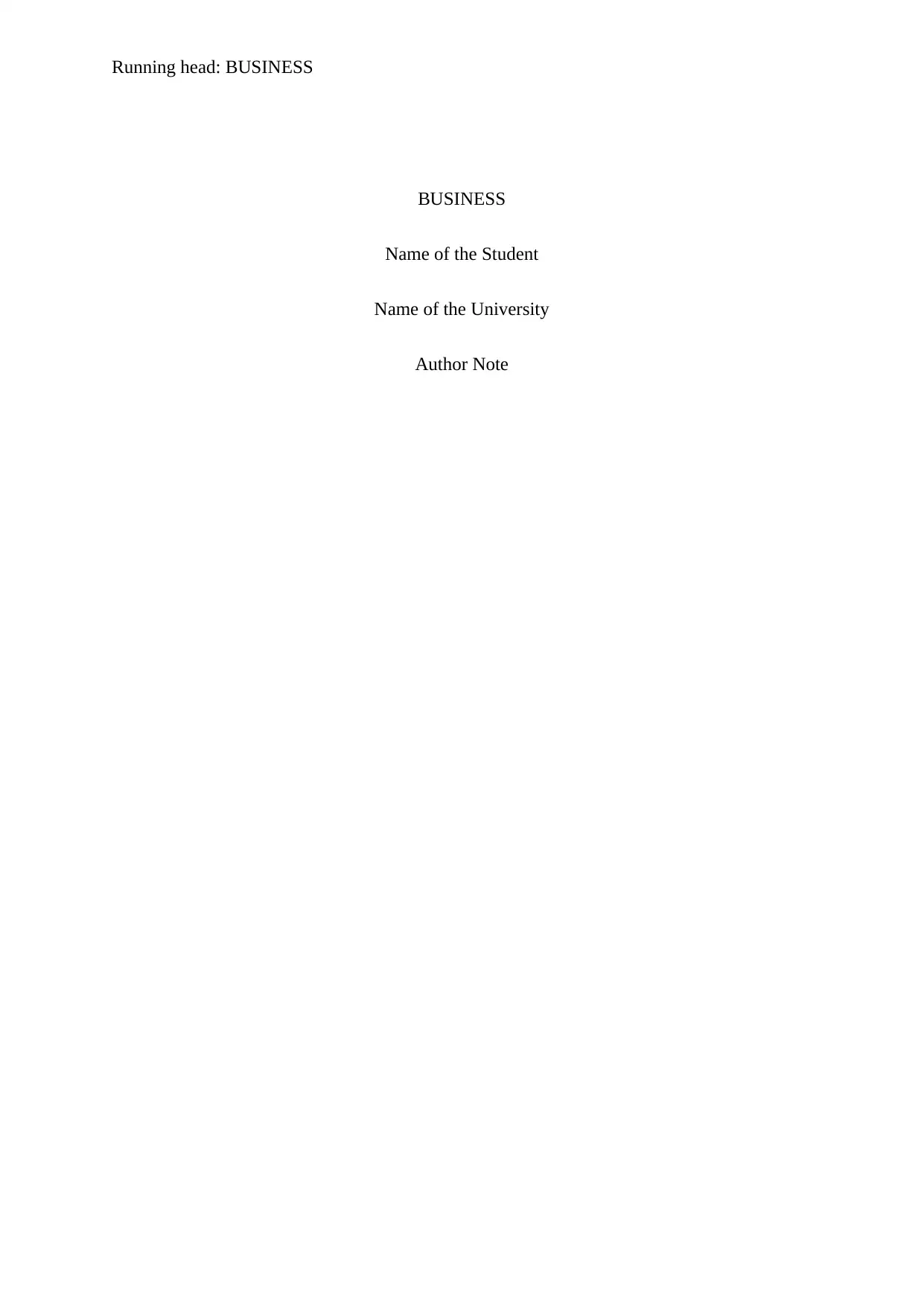
Running head: BUSINESS
BUSINESS
Name of the Student
Name of the University
Author Note
BUSINESS
Name of the Student
Name of the University
Author Note
Paraphrase This Document
Need a fresh take? Get an instant paraphrase of this document with our AI Paraphraser
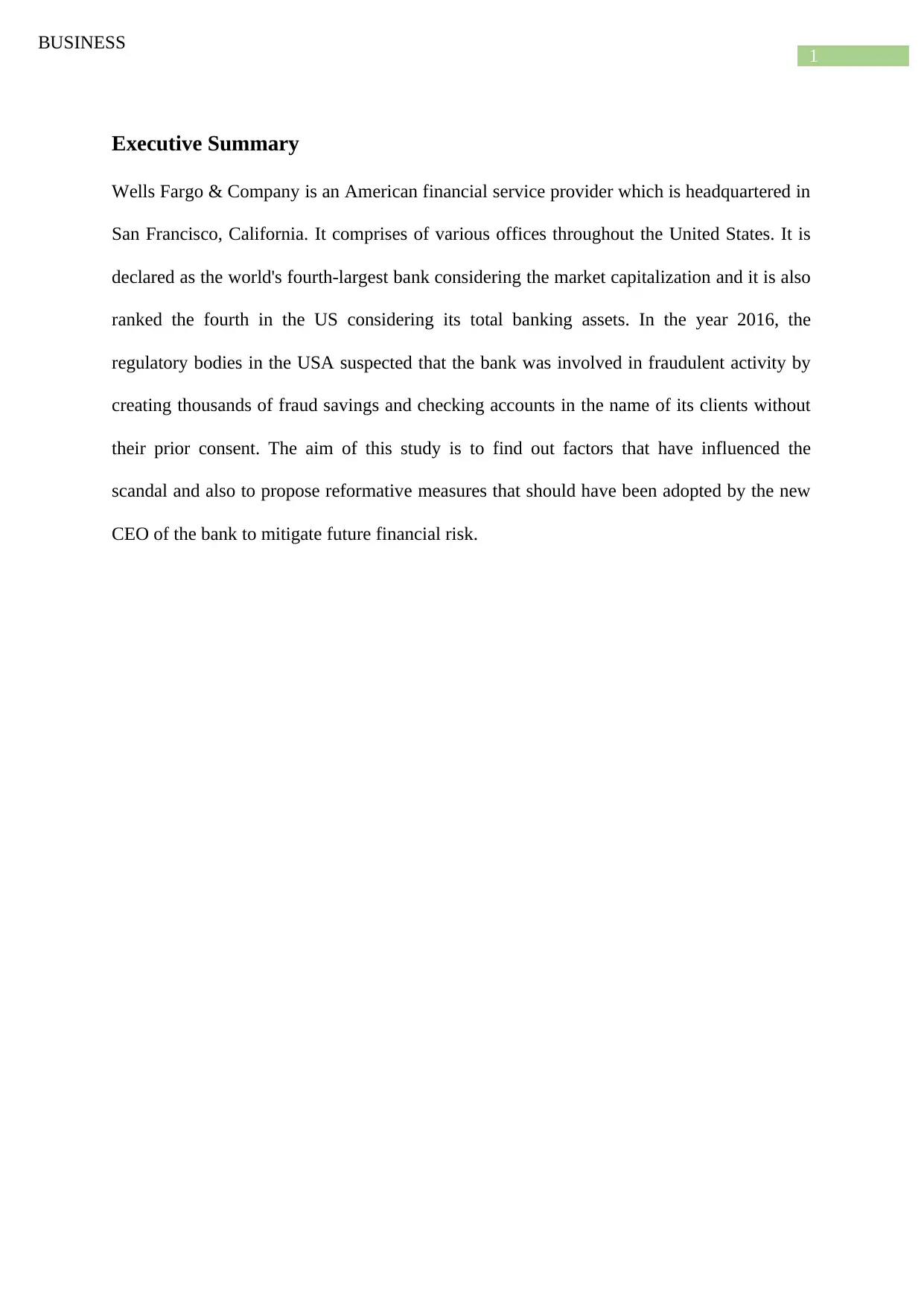
1
BUSINESS
Executive Summary
Wells Fargo & Company is an American financial service provider which is headquartered in
San Francisco, California. It comprises of various offices throughout the United States. It is
declared as the world's fourth-largest bank considering the market capitalization and it is also
ranked the fourth in the US considering its total banking assets. In the year 2016, the
regulatory bodies in the USA suspected that the bank was involved in fraudulent activity by
creating thousands of fraud savings and checking accounts in the name of its clients without
their prior consent. The aim of this study is to find out factors that have influenced the
scandal and also to propose reformative measures that should have been adopted by the new
CEO of the bank to mitigate future financial risk.
BUSINESS
Executive Summary
Wells Fargo & Company is an American financial service provider which is headquartered in
San Francisco, California. It comprises of various offices throughout the United States. It is
declared as the world's fourth-largest bank considering the market capitalization and it is also
ranked the fourth in the US considering its total banking assets. In the year 2016, the
regulatory bodies in the USA suspected that the bank was involved in fraudulent activity by
creating thousands of fraud savings and checking accounts in the name of its clients without
their prior consent. The aim of this study is to find out factors that have influenced the
scandal and also to propose reformative measures that should have been adopted by the new
CEO of the bank to mitigate future financial risk.
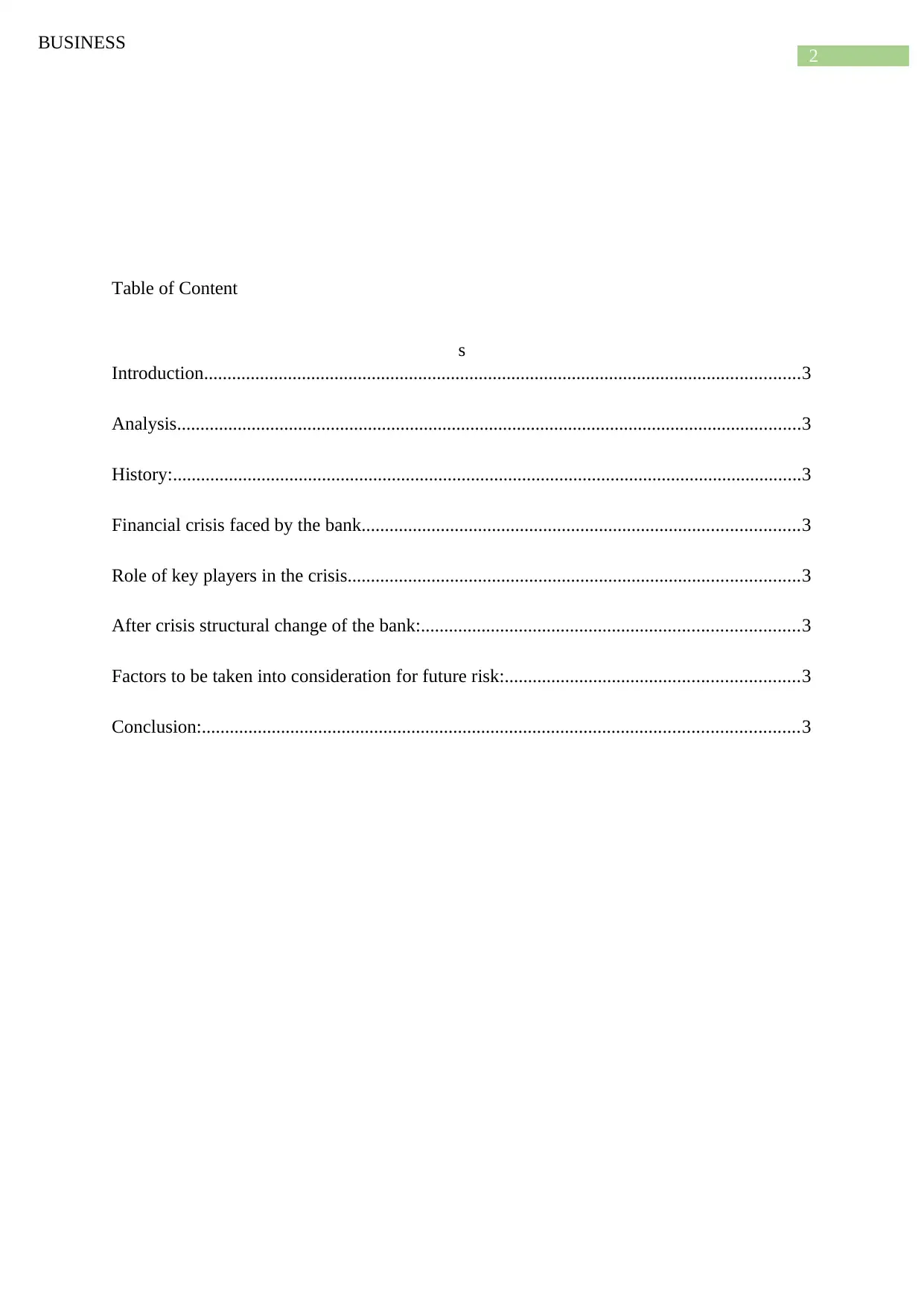
2
BUSINESS
Table of Content
s
Introduction................................................................................................................................3
Analysis......................................................................................................................................3
History:.......................................................................................................................................3
Financial crisis faced by the bank..............................................................................................3
Role of key players in the crisis.................................................................................................3
After crisis structural change of the bank:.................................................................................3
Factors to be taken into consideration for future risk:...............................................................3
Conclusion:................................................................................................................................3
BUSINESS
Table of Content
s
Introduction................................................................................................................................3
Analysis......................................................................................................................................3
History:.......................................................................................................................................3
Financial crisis faced by the bank..............................................................................................3
Role of key players in the crisis.................................................................................................3
After crisis structural change of the bank:.................................................................................3
Factors to be taken into consideration for future risk:...............................................................3
Conclusion:................................................................................................................................3
⊘ This is a preview!⊘
Do you want full access?
Subscribe today to unlock all pages.

Trusted by 1+ million students worldwide
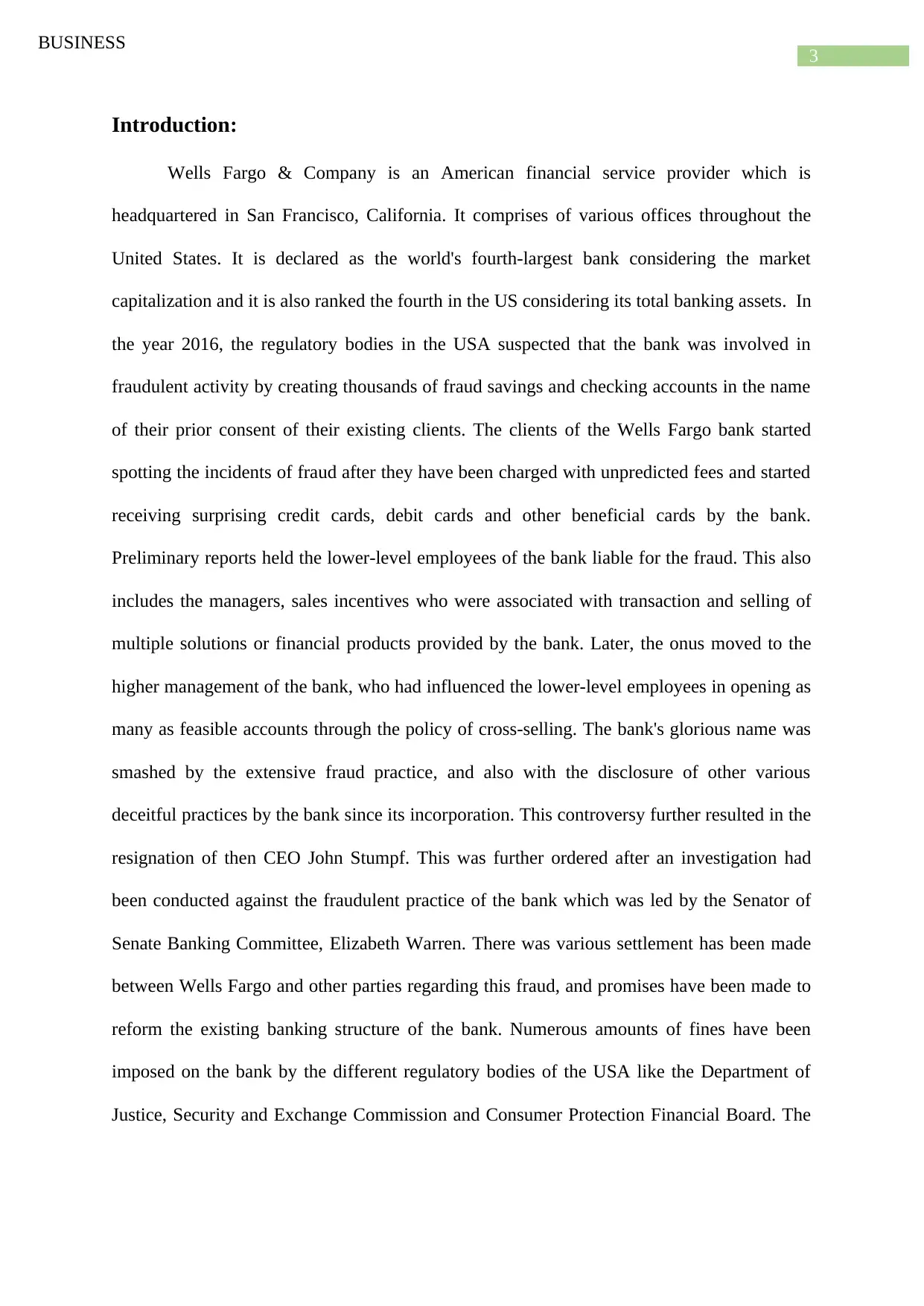
3
BUSINESS
Introduction:
Wells Fargo & Company is an American financial service provider which is
headquartered in San Francisco, California. It comprises of various offices throughout the
United States. It is declared as the world's fourth-largest bank considering the market
capitalization and it is also ranked the fourth in the US considering its total banking assets. In
the year 2016, the regulatory bodies in the USA suspected that the bank was involved in
fraudulent activity by creating thousands of fraud savings and checking accounts in the name
of their prior consent of their existing clients. The clients of the Wells Fargo bank started
spotting the incidents of fraud after they have been charged with unpredicted fees and started
receiving surprising credit cards, debit cards and other beneficial cards by the bank.
Preliminary reports held the lower-level employees of the bank liable for the fraud. This also
includes the managers, sales incentives who were associated with transaction and selling of
multiple solutions or financial products provided by the bank. Later, the onus moved to the
higher management of the bank, who had influenced the lower-level employees in opening as
many as feasible accounts through the policy of cross-selling. The bank's glorious name was
smashed by the extensive fraud practice, and also with the disclosure of other various
deceitful practices by the bank since its incorporation. This controversy further resulted in the
resignation of then CEO John Stumpf. This was further ordered after an investigation had
been conducted against the fraudulent practice of the bank which was led by the Senator of
Senate Banking Committee, Elizabeth Warren. There was various settlement has been made
between Wells Fargo and other parties regarding this fraud, and promises have been made to
reform the existing banking structure of the bank. Numerous amounts of fines have been
imposed on the bank by the different regulatory bodies of the USA like the Department of
Justice, Security and Exchange Commission and Consumer Protection Financial Board. The
BUSINESS
Introduction:
Wells Fargo & Company is an American financial service provider which is
headquartered in San Francisco, California. It comprises of various offices throughout the
United States. It is declared as the world's fourth-largest bank considering the market
capitalization and it is also ranked the fourth in the US considering its total banking assets. In
the year 2016, the regulatory bodies in the USA suspected that the bank was involved in
fraudulent activity by creating thousands of fraud savings and checking accounts in the name
of their prior consent of their existing clients. The clients of the Wells Fargo bank started
spotting the incidents of fraud after they have been charged with unpredicted fees and started
receiving surprising credit cards, debit cards and other beneficial cards by the bank.
Preliminary reports held the lower-level employees of the bank liable for the fraud. This also
includes the managers, sales incentives who were associated with transaction and selling of
multiple solutions or financial products provided by the bank. Later, the onus moved to the
higher management of the bank, who had influenced the lower-level employees in opening as
many as feasible accounts through the policy of cross-selling. The bank's glorious name was
smashed by the extensive fraud practice, and also with the disclosure of other various
deceitful practices by the bank since its incorporation. This controversy further resulted in the
resignation of then CEO John Stumpf. This was further ordered after an investigation had
been conducted against the fraudulent practice of the bank which was led by the Senator of
Senate Banking Committee, Elizabeth Warren. There was various settlement has been made
between Wells Fargo and other parties regarding this fraud, and promises have been made to
reform the existing banking structure of the bank. Numerous amounts of fines have been
imposed on the bank by the different regulatory bodies of the USA like the Department of
Justice, Security and Exchange Commission and Consumer Protection Financial Board. The
Paraphrase This Document
Need a fresh take? Get an instant paraphrase of this document with our AI Paraphraser
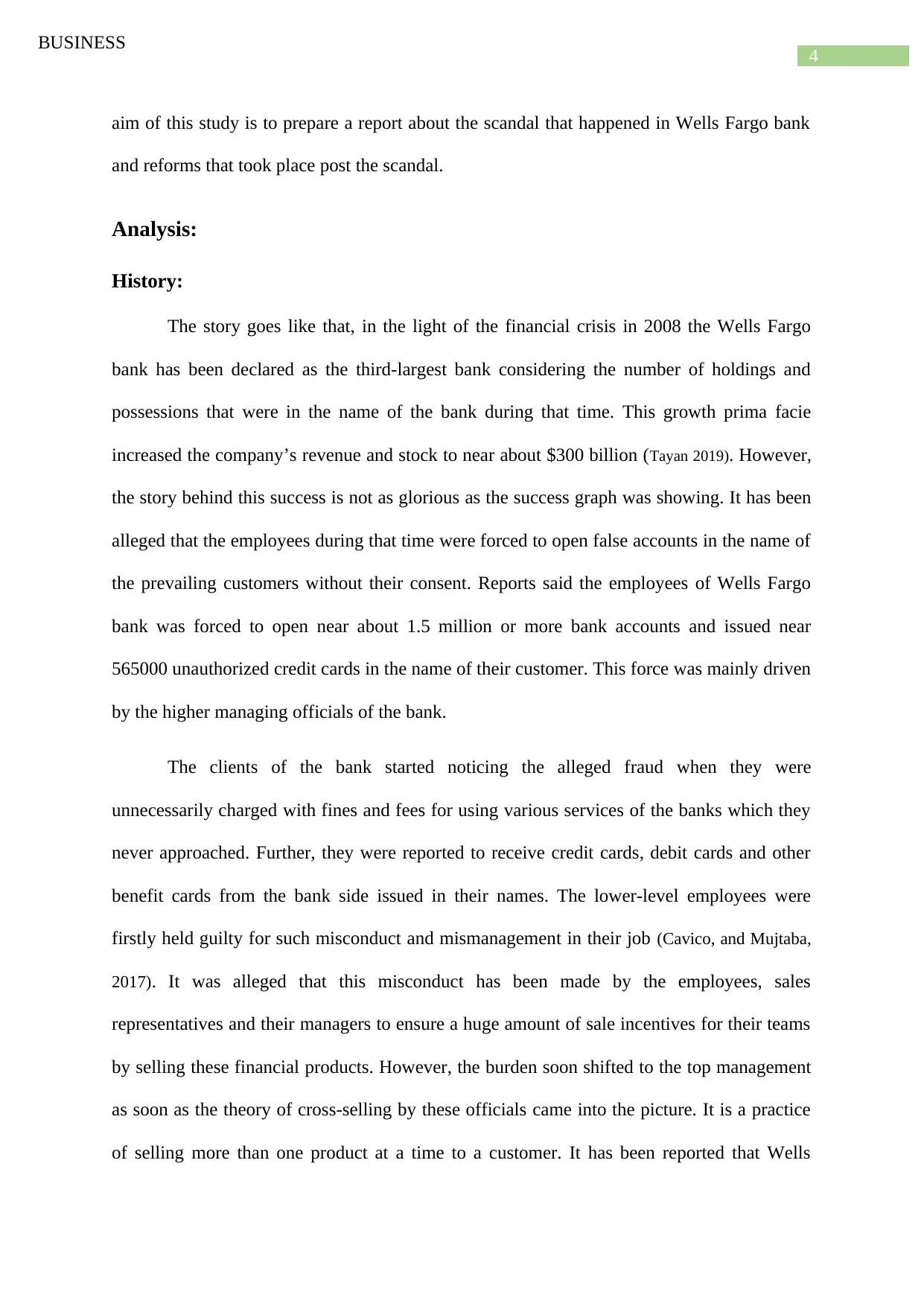
4
BUSINESS
aim of this study is to prepare a report about the scandal that happened in Wells Fargo bank
and reforms that took place post the scandal.
Analysis:
History:
The story goes like that, in the light of the financial crisis in 2008 the Wells Fargo
bank has been declared as the third-largest bank considering the number of holdings and
possessions that were in the name of the bank during that time. This growth prima facie
increased the company’s revenue and stock to near about $300 billion (Tayan 2019). However,
the story behind this success is not as glorious as the success graph was showing. It has been
alleged that the employees during that time were forced to open false accounts in the name of
the prevailing customers without their consent. Reports said the employees of Wells Fargo
bank was forced to open near about 1.5 million or more bank accounts and issued near
565000 unauthorized credit cards in the name of their customer. This force was mainly driven
by the higher managing officials of the bank.
The clients of the bank started noticing the alleged fraud when they were
unnecessarily charged with fines and fees for using various services of the banks which they
never approached. Further, they were reported to receive credit cards, debit cards and other
benefit cards from the bank side issued in their names. The lower-level employees were
firstly held guilty for such misconduct and mismanagement in their job (Cavico, and Mujtaba,
2017). It was alleged that this misconduct has been made by the employees, sales
representatives and their managers to ensure a huge amount of sale incentives for their teams
by selling these financial products. However, the burden soon shifted to the top management
as soon as the theory of cross-selling by these officials came into the picture. It is a practice
of selling more than one product at a time to a customer. It has been reported that Wells
BUSINESS
aim of this study is to prepare a report about the scandal that happened in Wells Fargo bank
and reforms that took place post the scandal.
Analysis:
History:
The story goes like that, in the light of the financial crisis in 2008 the Wells Fargo
bank has been declared as the third-largest bank considering the number of holdings and
possessions that were in the name of the bank during that time. This growth prima facie
increased the company’s revenue and stock to near about $300 billion (Tayan 2019). However,
the story behind this success is not as glorious as the success graph was showing. It has been
alleged that the employees during that time were forced to open false accounts in the name of
the prevailing customers without their consent. Reports said the employees of Wells Fargo
bank was forced to open near about 1.5 million or more bank accounts and issued near
565000 unauthorized credit cards in the name of their customer. This force was mainly driven
by the higher managing officials of the bank.
The clients of the bank started noticing the alleged fraud when they were
unnecessarily charged with fines and fees for using various services of the banks which they
never approached. Further, they were reported to receive credit cards, debit cards and other
benefit cards from the bank side issued in their names. The lower-level employees were
firstly held guilty for such misconduct and mismanagement in their job (Cavico, and Mujtaba,
2017). It was alleged that this misconduct has been made by the employees, sales
representatives and their managers to ensure a huge amount of sale incentives for their teams
by selling these financial products. However, the burden soon shifted to the top management
as soon as the theory of cross-selling by these officials came into the picture. It is a practice
of selling more than one product at a time to a customer. It has been reported that Wells
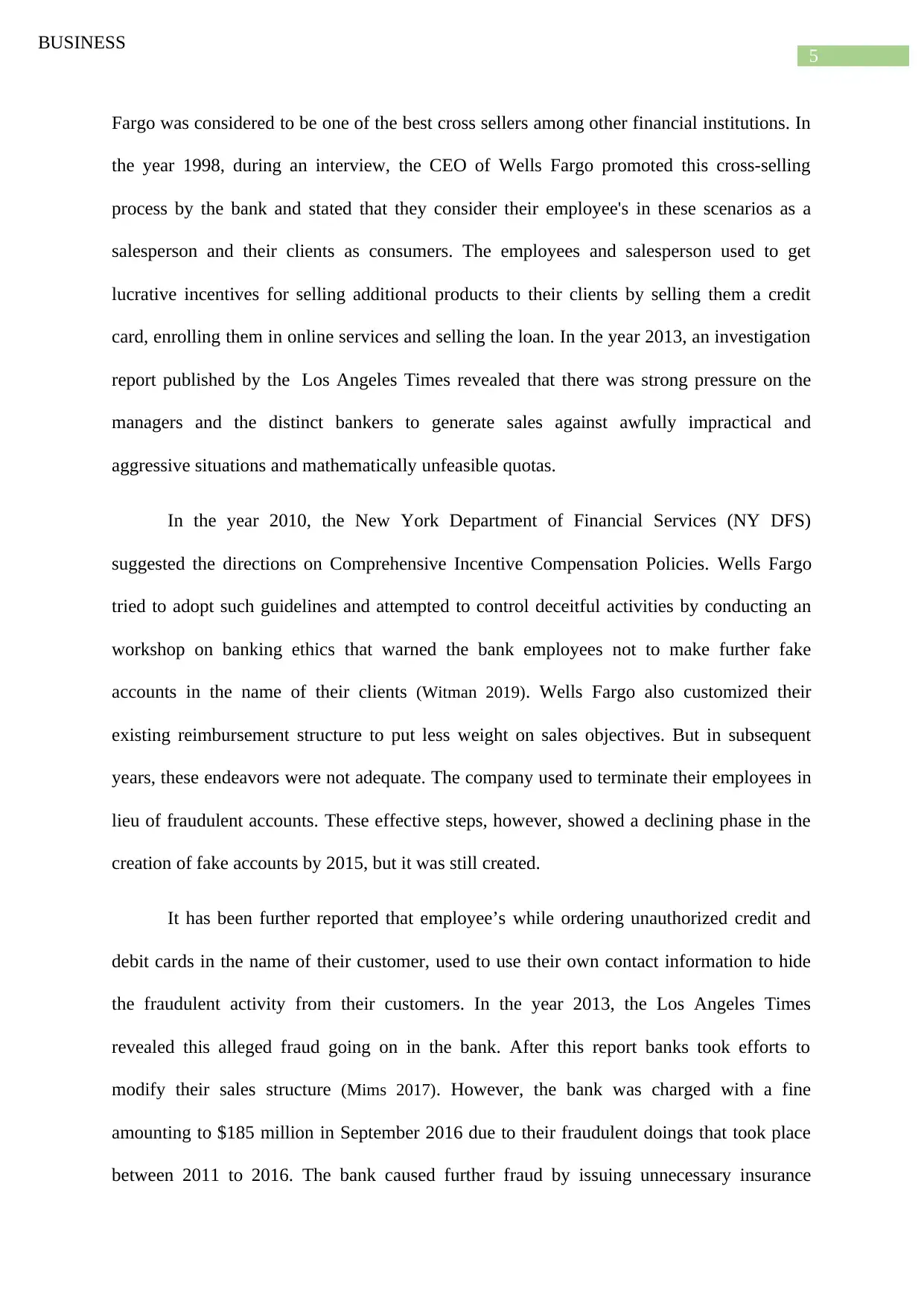
5
BUSINESS
Fargo was considered to be one of the best cross sellers among other financial institutions. In
the year 1998, during an interview, the CEO of Wells Fargo promoted this cross-selling
process by the bank and stated that they consider their employee's in these scenarios as a
salesperson and their clients as consumers. The employees and salesperson used to get
lucrative incentives for selling additional products to their clients by selling them a credit
card, enrolling them in online services and selling the loan. In the year 2013, an investigation
report published by the Los Angeles Times revealed that there was strong pressure on the
managers and the distinct bankers to generate sales against awfully impractical and
aggressive situations and mathematically unfeasible quotas.
In the year 2010, the New York Department of Financial Services (NY DFS)
suggested the directions on Comprehensive Incentive Compensation Policies. Wells Fargo
tried to adopt such guidelines and attempted to control deceitful activities by conducting an
workshop on banking ethics that warned the bank employees not to make further fake
accounts in the name of their clients (Witman 2019). Wells Fargo also customized their
existing reimbursement structure to put less weight on sales objectives. But in subsequent
years, these endeavors were not adequate. The company used to terminate their employees in
lieu of fraudulent accounts. These effective steps, however, showed a declining phase in the
creation of fake accounts by 2015, but it was still created.
It has been further reported that employee’s while ordering unauthorized credit and
debit cards in the name of their customer, used to use their own contact information to hide
the fraudulent activity from their customers. In the year 2013, the Los Angeles Times
revealed this alleged fraud going on in the bank. After this report banks took efforts to
modify their sales structure (Mims 2017). However, the bank was charged with a fine
amounting to $185 million in September 2016 due to their fraudulent doings that took place
between 2011 to 2016. The bank caused further fraud by issuing unnecessary insurance
BUSINESS
Fargo was considered to be one of the best cross sellers among other financial institutions. In
the year 1998, during an interview, the CEO of Wells Fargo promoted this cross-selling
process by the bank and stated that they consider their employee's in these scenarios as a
salesperson and their clients as consumers. The employees and salesperson used to get
lucrative incentives for selling additional products to their clients by selling them a credit
card, enrolling them in online services and selling the loan. In the year 2013, an investigation
report published by the Los Angeles Times revealed that there was strong pressure on the
managers and the distinct bankers to generate sales against awfully impractical and
aggressive situations and mathematically unfeasible quotas.
In the year 2010, the New York Department of Financial Services (NY DFS)
suggested the directions on Comprehensive Incentive Compensation Policies. Wells Fargo
tried to adopt such guidelines and attempted to control deceitful activities by conducting an
workshop on banking ethics that warned the bank employees not to make further fake
accounts in the name of their clients (Witman 2019). Wells Fargo also customized their
existing reimbursement structure to put less weight on sales objectives. But in subsequent
years, these endeavors were not adequate. The company used to terminate their employees in
lieu of fraudulent accounts. These effective steps, however, showed a declining phase in the
creation of fake accounts by 2015, but it was still created.
It has been further reported that employee’s while ordering unauthorized credit and
debit cards in the name of their customer, used to use their own contact information to hide
the fraudulent activity from their customers. In the year 2013, the Los Angeles Times
revealed this alleged fraud going on in the bank. After this report banks took efforts to
modify their sales structure (Mims 2017). However, the bank was charged with a fine
amounting to $185 million in September 2016 due to their fraudulent doings that took place
between 2011 to 2016. The bank caused further fraud by issuing unnecessary insurance
⊘ This is a preview!⊘
Do you want full access?
Subscribe today to unlock all pages.

Trusted by 1+ million students worldwide
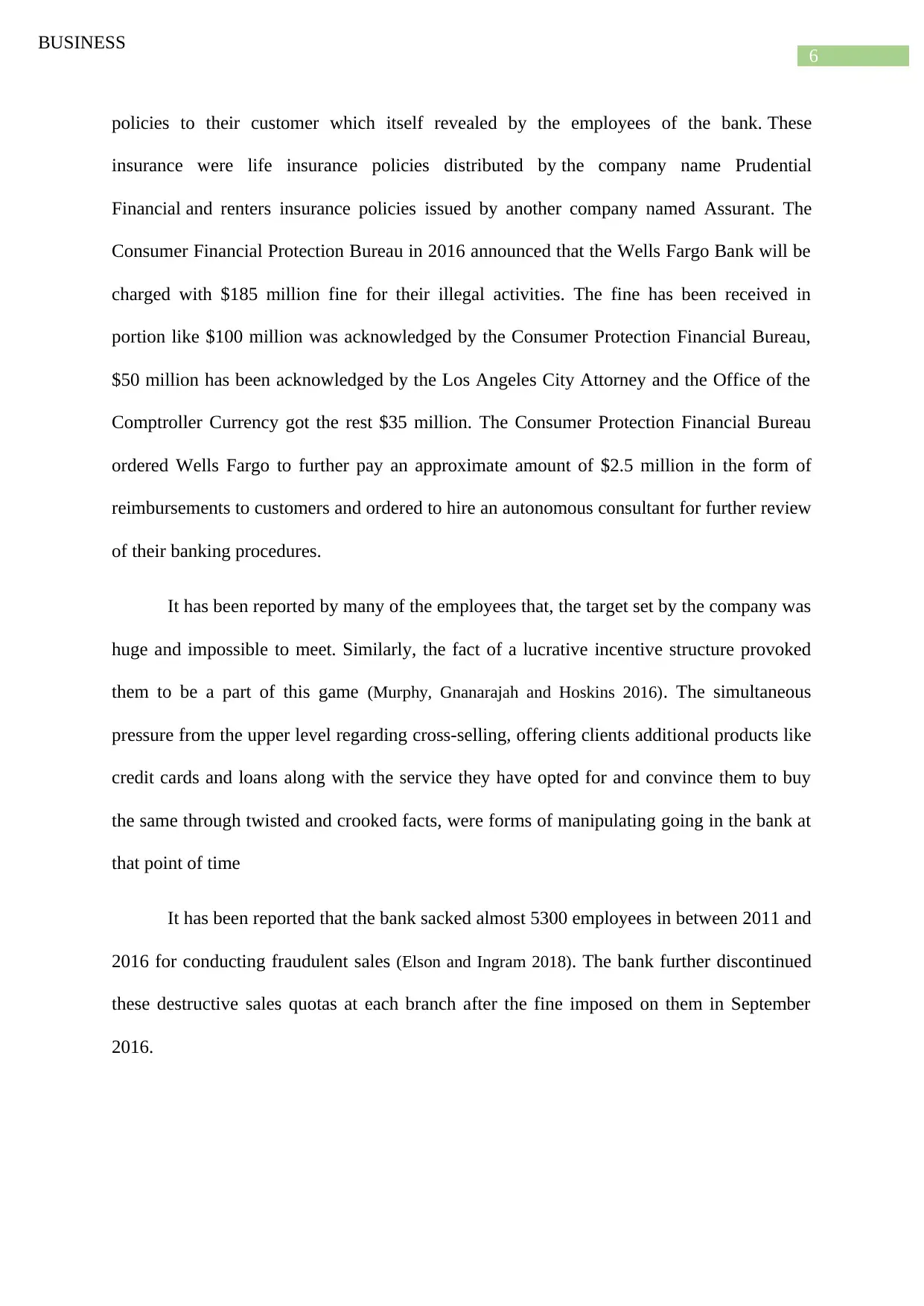
6
BUSINESS
policies to their customer which itself revealed by the employees of the bank. These
insurance were life insurance policies distributed by the company name Prudential
Financial and renters insurance policies issued by another company named Assurant. The
Consumer Financial Protection Bureau in 2016 announced that the Wells Fargo Bank will be
charged with $185 million fine for their illegal activities. The fine has been received in
portion like $100 million was acknowledged by the Consumer Protection Financial Bureau,
$50 million has been acknowledged by the Los Angeles City Attorney and the Office of the
Comptroller Currency got the rest $35 million. The Consumer Protection Financial Bureau
ordered Wells Fargo to further pay an approximate amount of $2.5 million in the form of
reimbursements to customers and ordered to hire an autonomous consultant for further review
of their banking procedures.
It has been reported by many of the employees that, the target set by the company was
huge and impossible to meet. Similarly, the fact of a lucrative incentive structure provoked
them to be a part of this game (Murphy, Gnanarajah and Hoskins 2016). The simultaneous
pressure from the upper level regarding cross-selling, offering clients additional products like
credit cards and loans along with the service they have opted for and convince them to buy
the same through twisted and crooked facts, were forms of manipulating going in the bank at
that point of time
It has been reported that the bank sacked almost 5300 employees in between 2011 and
2016 for conducting fraudulent sales (Elson and Ingram 2018). The bank further discontinued
these destructive sales quotas at each branch after the fine imposed on them in September
2016.
BUSINESS
policies to their customer which itself revealed by the employees of the bank. These
insurance were life insurance policies distributed by the company name Prudential
Financial and renters insurance policies issued by another company named Assurant. The
Consumer Financial Protection Bureau in 2016 announced that the Wells Fargo Bank will be
charged with $185 million fine for their illegal activities. The fine has been received in
portion like $100 million was acknowledged by the Consumer Protection Financial Bureau,
$50 million has been acknowledged by the Los Angeles City Attorney and the Office of the
Comptroller Currency got the rest $35 million. The Consumer Protection Financial Bureau
ordered Wells Fargo to further pay an approximate amount of $2.5 million in the form of
reimbursements to customers and ordered to hire an autonomous consultant for further review
of their banking procedures.
It has been reported by many of the employees that, the target set by the company was
huge and impossible to meet. Similarly, the fact of a lucrative incentive structure provoked
them to be a part of this game (Murphy, Gnanarajah and Hoskins 2016). The simultaneous
pressure from the upper level regarding cross-selling, offering clients additional products like
credit cards and loans along with the service they have opted for and convince them to buy
the same through twisted and crooked facts, were forms of manipulating going in the bank at
that point of time
It has been reported that the bank sacked almost 5300 employees in between 2011 and
2016 for conducting fraudulent sales (Elson and Ingram 2018). The bank further discontinued
these destructive sales quotas at each branch after the fine imposed on them in September
2016.
Paraphrase This Document
Need a fresh take? Get an instant paraphrase of this document with our AI Paraphraser
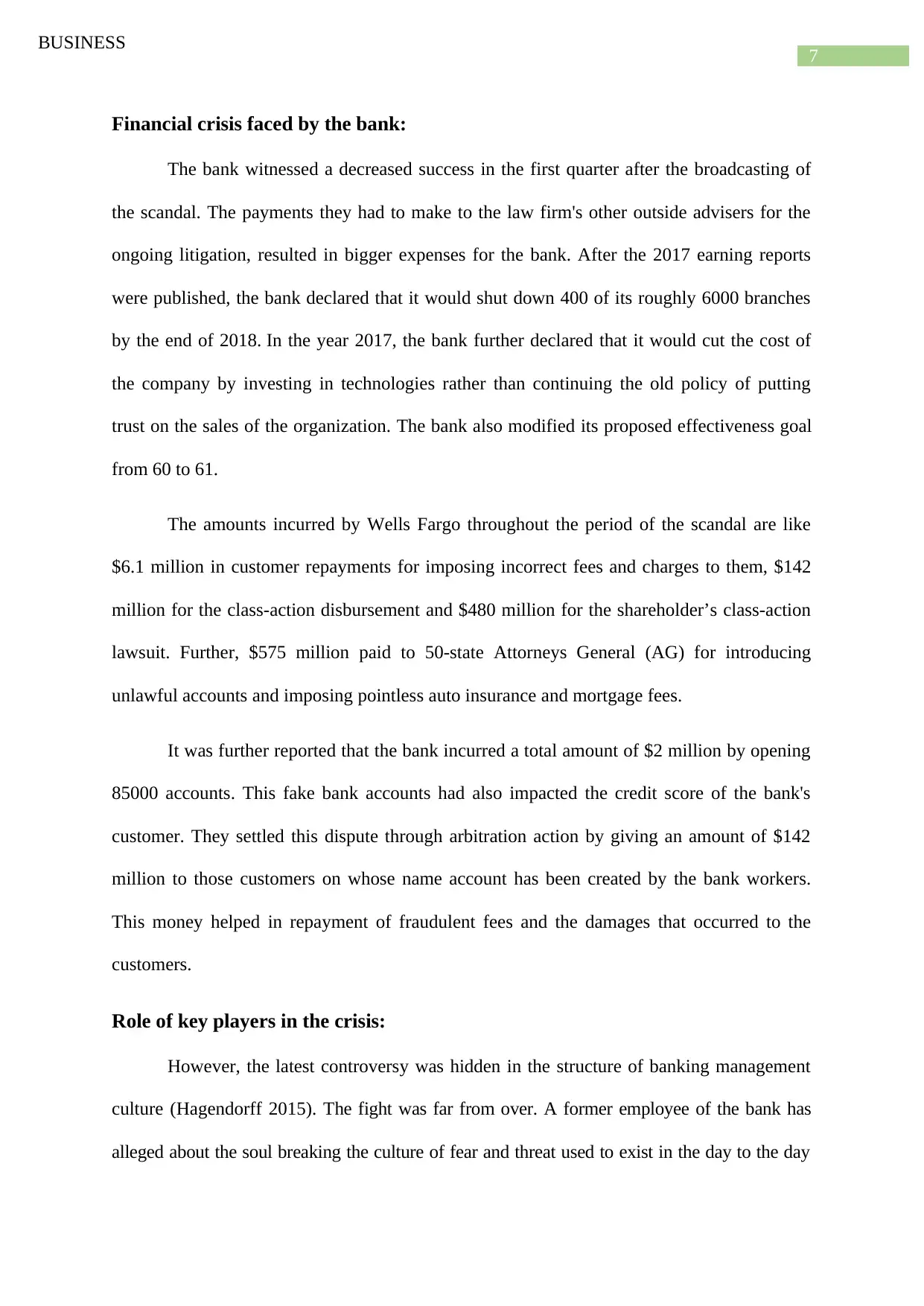
7
BUSINESS
Financial crisis faced by the bank:
The bank witnessed a decreased success in the first quarter after the broadcasting of
the scandal. The payments they had to make to the law firm's other outside advisers for the
ongoing litigation, resulted in bigger expenses for the bank. After the 2017 earning reports
were published, the bank declared that it would shut down 400 of its roughly 6000 branches
by the end of 2018. In the year 2017, the bank further declared that it would cut the cost of
the company by investing in technologies rather than continuing the old policy of putting
trust on the sales of the organization. The bank also modified its proposed effectiveness goal
from 60 to 61.
The amounts incurred by Wells Fargo throughout the period of the scandal are like
$6.1 million in customer repayments for imposing incorrect fees and charges to them, $142
million for the class-action disbursement and $480 million for the shareholder’s class-action
lawsuit. Further, $575 million paid to 50-state Attorneys General (AG) for introducing
unlawful accounts and imposing pointless auto insurance and mortgage fees.
It was further reported that the bank incurred a total amount of $2 million by opening
85000 accounts. This fake bank accounts had also impacted the credit score of the bank's
customer. They settled this dispute through arbitration action by giving an amount of $142
million to those customers on whose name account has been created by the bank workers.
This money helped in repayment of fraudulent fees and the damages that occurred to the
customers.
Role of key players in the crisis:
However, the latest controversy was hidden in the structure of banking management
culture (Hagendorff 2015). The fight was far from over. A former employee of the bank has
alleged about the soul breaking the culture of fear and threat used to exist in the day to the day
BUSINESS
Financial crisis faced by the bank:
The bank witnessed a decreased success in the first quarter after the broadcasting of
the scandal. The payments they had to make to the law firm's other outside advisers for the
ongoing litigation, resulted in bigger expenses for the bank. After the 2017 earning reports
were published, the bank declared that it would shut down 400 of its roughly 6000 branches
by the end of 2018. In the year 2017, the bank further declared that it would cut the cost of
the company by investing in technologies rather than continuing the old policy of putting
trust on the sales of the organization. The bank also modified its proposed effectiveness goal
from 60 to 61.
The amounts incurred by Wells Fargo throughout the period of the scandal are like
$6.1 million in customer repayments for imposing incorrect fees and charges to them, $142
million for the class-action disbursement and $480 million for the shareholder’s class-action
lawsuit. Further, $575 million paid to 50-state Attorneys General (AG) for introducing
unlawful accounts and imposing pointless auto insurance and mortgage fees.
It was further reported that the bank incurred a total amount of $2 million by opening
85000 accounts. This fake bank accounts had also impacted the credit score of the bank's
customer. They settled this dispute through arbitration action by giving an amount of $142
million to those customers on whose name account has been created by the bank workers.
This money helped in repayment of fraudulent fees and the damages that occurred to the
customers.
Role of key players in the crisis:
However, the latest controversy was hidden in the structure of banking management
culture (Hagendorff 2015). The fight was far from over. A former employee of the bank has
alleged about the soul breaking the culture of fear and threat used to exist in the day to the day
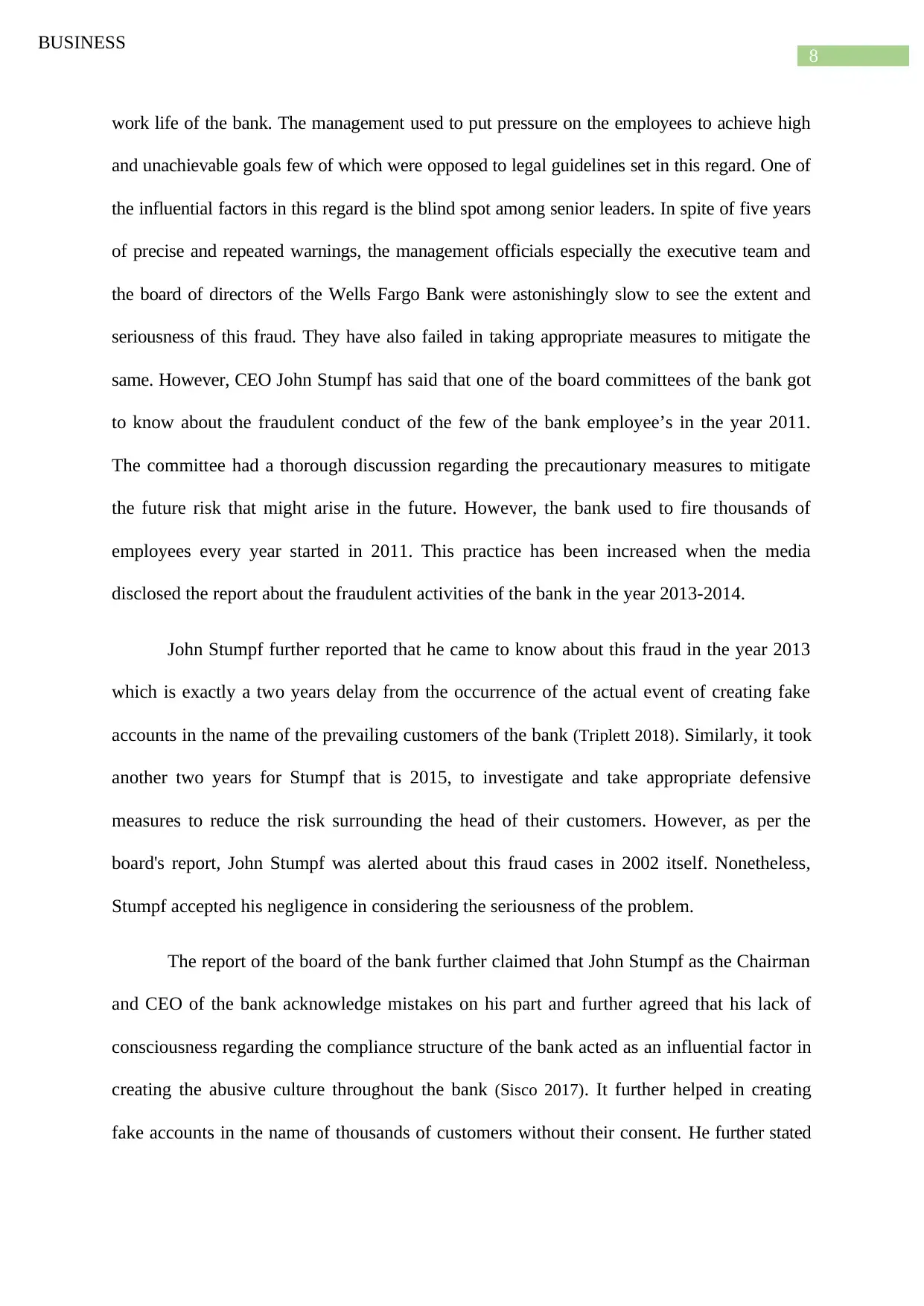
8
BUSINESS
work life of the bank. The management used to put pressure on the employees to achieve high
and unachievable goals few of which were opposed to legal guidelines set in this regard. One of
the influential factors in this regard is the blind spot among senior leaders. In spite of five years
of precise and repeated warnings, the management officials especially the executive team and
the board of directors of the Wells Fargo Bank were astonishingly slow to see the extent and
seriousness of this fraud. They have also failed in taking appropriate measures to mitigate the
same. However, CEO John Stumpf has said that one of the board committees of the bank got
to know about the fraudulent conduct of the few of the bank employee’s in the year 2011.
The committee had a thorough discussion regarding the precautionary measures to mitigate
the future risk that might arise in the future. However, the bank used to fire thousands of
employees every year started in 2011. This practice has been increased when the media
disclosed the report about the fraudulent activities of the bank in the year 2013-2014.
John Stumpf further reported that he came to know about this fraud in the year 2013
which is exactly a two years delay from the occurrence of the actual event of creating fake
accounts in the name of the prevailing customers of the bank (Triplett 2018). Similarly, it took
another two years for Stumpf that is 2015, to investigate and take appropriate defensive
measures to reduce the risk surrounding the head of their customers. However, as per the
board's report, John Stumpf was alerted about this fraud cases in 2002 itself. Nonetheless,
Stumpf accepted his negligence in considering the seriousness of the problem.
The report of the board of the bank further claimed that John Stumpf as the Chairman
and CEO of the bank acknowledge mistakes on his part and further agreed that his lack of
consciousness regarding the compliance structure of the bank acted as an influential factor in
creating the abusive culture throughout the bank (Sisco 2017). It further helped in creating
fake accounts in the name of thousands of customers without their consent. He further stated
BUSINESS
work life of the bank. The management used to put pressure on the employees to achieve high
and unachievable goals few of which were opposed to legal guidelines set in this regard. One of
the influential factors in this regard is the blind spot among senior leaders. In spite of five years
of precise and repeated warnings, the management officials especially the executive team and
the board of directors of the Wells Fargo Bank were astonishingly slow to see the extent and
seriousness of this fraud. They have also failed in taking appropriate measures to mitigate the
same. However, CEO John Stumpf has said that one of the board committees of the bank got
to know about the fraudulent conduct of the few of the bank employee’s in the year 2011.
The committee had a thorough discussion regarding the precautionary measures to mitigate
the future risk that might arise in the future. However, the bank used to fire thousands of
employees every year started in 2011. This practice has been increased when the media
disclosed the report about the fraudulent activities of the bank in the year 2013-2014.
John Stumpf further reported that he came to know about this fraud in the year 2013
which is exactly a two years delay from the occurrence of the actual event of creating fake
accounts in the name of the prevailing customers of the bank (Triplett 2018). Similarly, it took
another two years for Stumpf that is 2015, to investigate and take appropriate defensive
measures to reduce the risk surrounding the head of their customers. However, as per the
board's report, John Stumpf was alerted about this fraud cases in 2002 itself. Nonetheless,
Stumpf accepted his negligence in considering the seriousness of the problem.
The report of the board of the bank further claimed that John Stumpf as the Chairman
and CEO of the bank acknowledge mistakes on his part and further agreed that his lack of
consciousness regarding the compliance structure of the bank acted as an influential factor in
creating the abusive culture throughout the bank (Sisco 2017). It further helped in creating
fake accounts in the name of thousands of customers without their consent. He further stated
⊘ This is a preview!⊘
Do you want full access?
Subscribe today to unlock all pages.

Trusted by 1+ million students worldwide
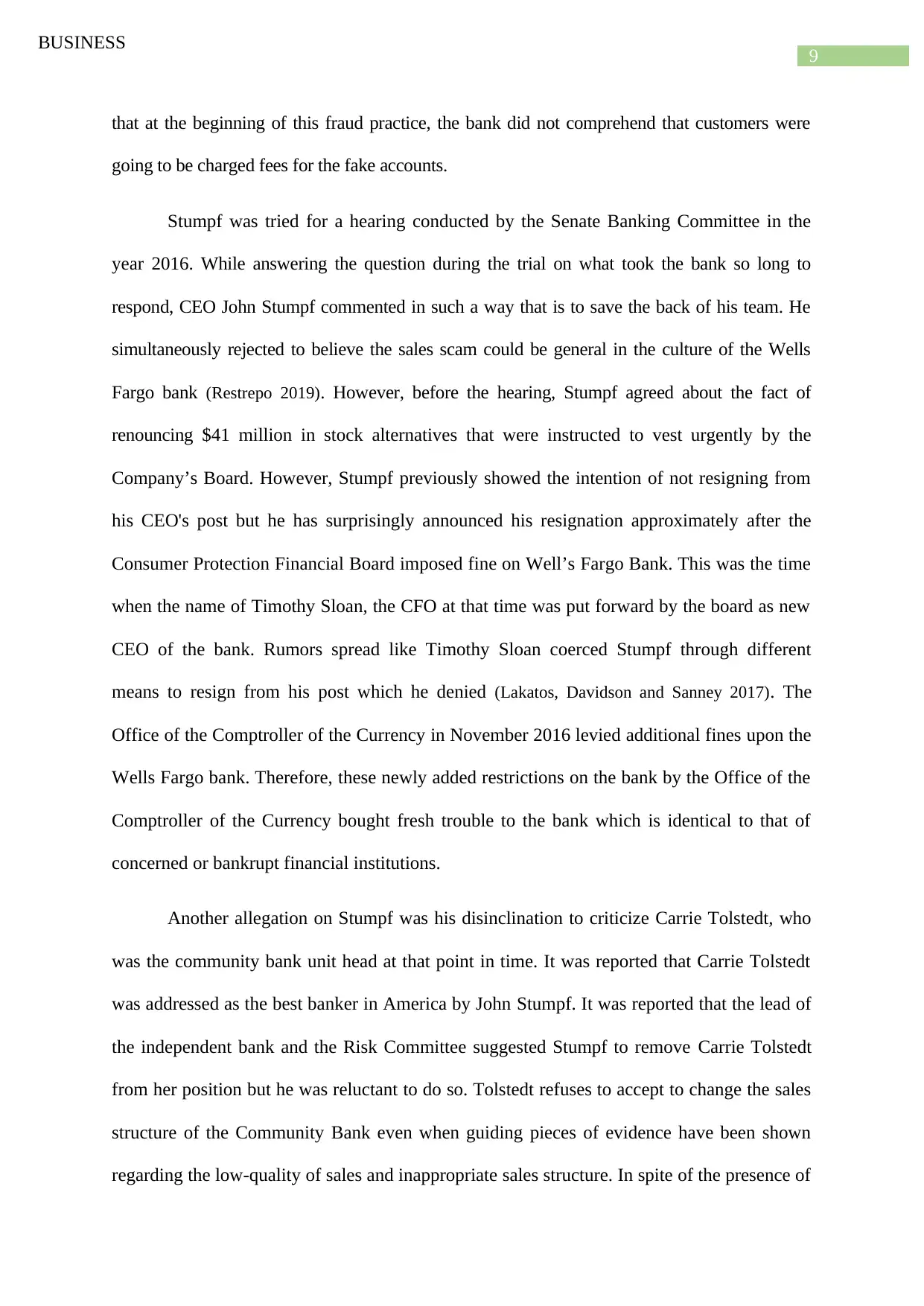
9
BUSINESS
that at the beginning of this fraud practice, the bank did not comprehend that customers were
going to be charged fees for the fake accounts.
Stumpf was tried for a hearing conducted by the Senate Banking Committee in the
year 2016. While answering the question during the trial on what took the bank so long to
respond, CEO John Stumpf commented in such a way that is to save the back of his team. He
simultaneously rejected to believe the sales scam could be general in the culture of the Wells
Fargo bank (Restrepo 2019). However, before the hearing, Stumpf agreed about the fact of
renouncing $41 million in stock alternatives that were instructed to vest urgently by the
Company’s Board. However, Stumpf previously showed the intention of not resigning from
his CEO's post but he has surprisingly announced his resignation approximately after the
Consumer Protection Financial Board imposed fine on Well’s Fargo Bank. This was the time
when the name of Timothy Sloan, the CFO at that time was put forward by the board as new
CEO of the bank. Rumors spread like Timothy Sloan coerced Stumpf through different
means to resign from his post which he denied (Lakatos, Davidson and Sanney 2017). The
Office of the Comptroller of the Currency in November 2016 levied additional fines upon the
Wells Fargo bank. Therefore, these newly added restrictions on the bank by the Office of the
Comptroller of the Currency bought fresh trouble to the bank which is identical to that of
concerned or bankrupt financial institutions.
Another allegation on Stumpf was his disinclination to criticize Carrie Tolstedt, who
was the community bank unit head at that point in time. It was reported that Carrie Tolstedt
was addressed as the best banker in America by John Stumpf. It was reported that the lead of
the independent bank and the Risk Committee suggested Stumpf to remove Carrie Tolstedt
from her position but he was reluctant to do so. Tolstedt refuses to accept to change the sales
structure of the Community Bank even when guiding pieces of evidence have been shown
regarding the low-quality of sales and inappropriate sales structure. In spite of the presence of
BUSINESS
that at the beginning of this fraud practice, the bank did not comprehend that customers were
going to be charged fees for the fake accounts.
Stumpf was tried for a hearing conducted by the Senate Banking Committee in the
year 2016. While answering the question during the trial on what took the bank so long to
respond, CEO John Stumpf commented in such a way that is to save the back of his team. He
simultaneously rejected to believe the sales scam could be general in the culture of the Wells
Fargo bank (Restrepo 2019). However, before the hearing, Stumpf agreed about the fact of
renouncing $41 million in stock alternatives that were instructed to vest urgently by the
Company’s Board. However, Stumpf previously showed the intention of not resigning from
his CEO's post but he has surprisingly announced his resignation approximately after the
Consumer Protection Financial Board imposed fine on Well’s Fargo Bank. This was the time
when the name of Timothy Sloan, the CFO at that time was put forward by the board as new
CEO of the bank. Rumors spread like Timothy Sloan coerced Stumpf through different
means to resign from his post which he denied (Lakatos, Davidson and Sanney 2017). The
Office of the Comptroller of the Currency in November 2016 levied additional fines upon the
Wells Fargo bank. Therefore, these newly added restrictions on the bank by the Office of the
Comptroller of the Currency bought fresh trouble to the bank which is identical to that of
concerned or bankrupt financial institutions.
Another allegation on Stumpf was his disinclination to criticize Carrie Tolstedt, who
was the community bank unit head at that point in time. It was reported that Carrie Tolstedt
was addressed as the best banker in America by John Stumpf. It was reported that the lead of
the independent bank and the Risk Committee suggested Stumpf to remove Carrie Tolstedt
from her position but he was reluctant to do so. Tolstedt refuses to accept to change the sales
structure of the Community Bank even when guiding pieces of evidence have been shown
regarding the low-quality of sales and inappropriate sales structure. In spite of the presence of
Paraphrase This Document
Need a fresh take? Get an instant paraphrase of this document with our AI Paraphraser
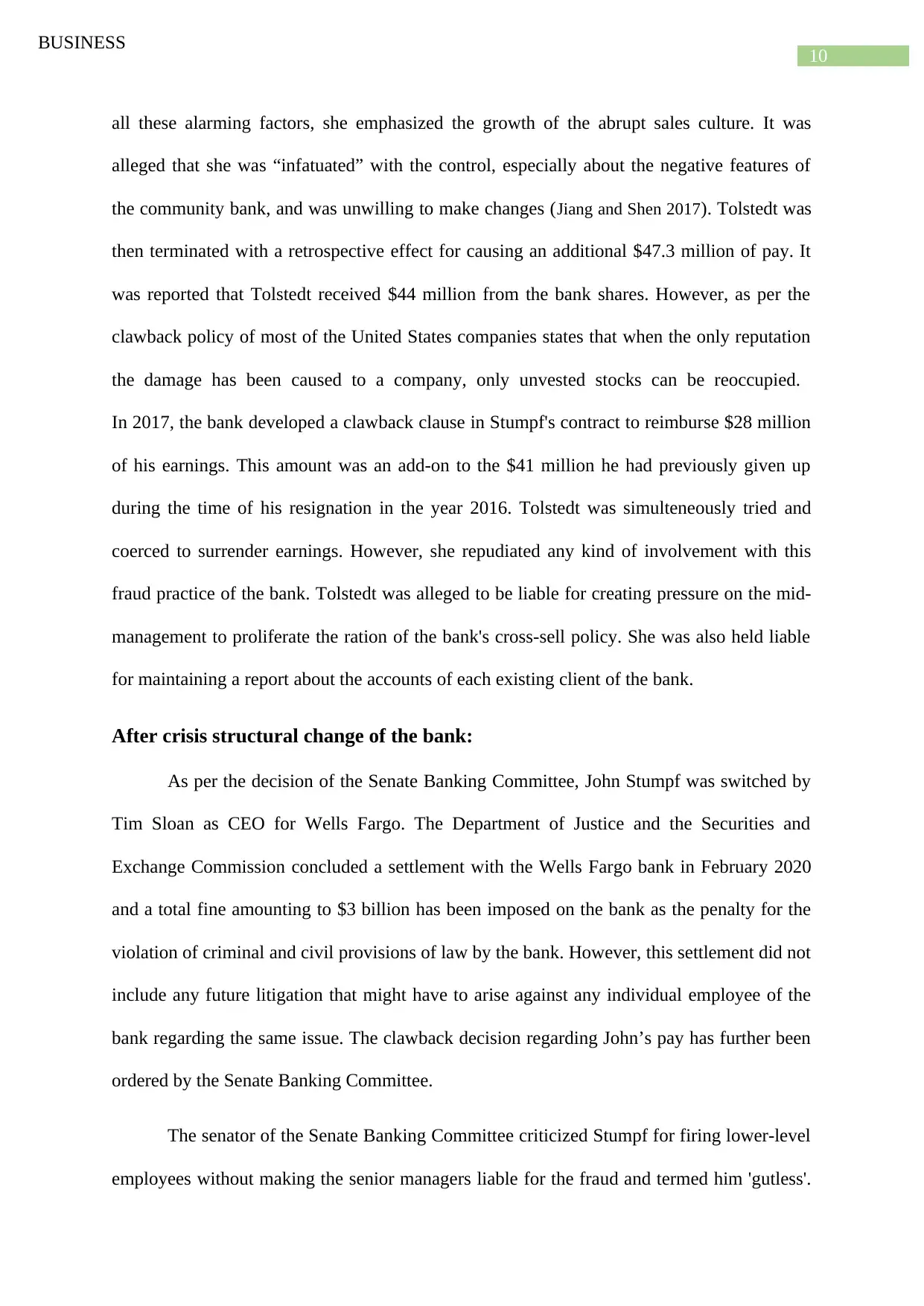
10
BUSINESS
all these alarming factors, she emphasized the growth of the abrupt sales culture. It was
alleged that she was “infatuated” with the control, especially about the negative features of
the community bank, and was unwilling to make changes (Jiang and Shen 2017). Tolstedt was
then terminated with a retrospective effect for causing an additional $47.3 million of pay. It
was reported that Tolstedt received $44 million from the bank shares. However, as per the
clawback policy of most of the United States companies states that when the only reputation
the damage has been caused to a company, only unvested stocks can be reoccupied.
In 2017, the bank developed a clawback clause in Stumpf's contract to reimburse $28 million
of his earnings. This amount was an add-on to the $41 million he had previously given up
during the time of his resignation in the year 2016. Tolstedt was simulteneously tried and
coerced to surrender earnings. However, she repudiated any kind of involvement with this
fraud practice of the bank. Tolstedt was alleged to be liable for creating pressure on the mid-
management to proliferate the ration of the bank's cross-sell policy. She was also held liable
for maintaining a report about the accounts of each existing client of the bank.
After crisis structural change of the bank:
As per the decision of the Senate Banking Committee, John Stumpf was switched by
Tim Sloan as CEO for Wells Fargo. The Department of Justice and the Securities and
Exchange Commission concluded a settlement with the Wells Fargo bank in February 2020
and a total fine amounting to $3 billion has been imposed on the bank as the penalty for the
violation of criminal and civil provisions of law by the bank. However, this settlement did not
include any future litigation that might have to arise against any individual employee of the
bank regarding the same issue. The clawback decision regarding John’s pay has further been
ordered by the Senate Banking Committee.
The senator of the Senate Banking Committee criticized Stumpf for firing lower-level
employees without making the senior managers liable for the fraud and termed him 'gutless'.
BUSINESS
all these alarming factors, she emphasized the growth of the abrupt sales culture. It was
alleged that she was “infatuated” with the control, especially about the negative features of
the community bank, and was unwilling to make changes (Jiang and Shen 2017). Tolstedt was
then terminated with a retrospective effect for causing an additional $47.3 million of pay. It
was reported that Tolstedt received $44 million from the bank shares. However, as per the
clawback policy of most of the United States companies states that when the only reputation
the damage has been caused to a company, only unvested stocks can be reoccupied.
In 2017, the bank developed a clawback clause in Stumpf's contract to reimburse $28 million
of his earnings. This amount was an add-on to the $41 million he had previously given up
during the time of his resignation in the year 2016. Tolstedt was simulteneously tried and
coerced to surrender earnings. However, she repudiated any kind of involvement with this
fraud practice of the bank. Tolstedt was alleged to be liable for creating pressure on the mid-
management to proliferate the ration of the bank's cross-sell policy. She was also held liable
for maintaining a report about the accounts of each existing client of the bank.
After crisis structural change of the bank:
As per the decision of the Senate Banking Committee, John Stumpf was switched by
Tim Sloan as CEO for Wells Fargo. The Department of Justice and the Securities and
Exchange Commission concluded a settlement with the Wells Fargo bank in February 2020
and a total fine amounting to $3 billion has been imposed on the bank as the penalty for the
violation of criminal and civil provisions of law by the bank. However, this settlement did not
include any future litigation that might have to arise against any individual employee of the
bank regarding the same issue. The clawback decision regarding John’s pay has further been
ordered by the Senate Banking Committee.
The senator of the Senate Banking Committee criticized Stumpf for firing lower-level
employees without making the senior managers liable for the fraud and termed him 'gutless'.
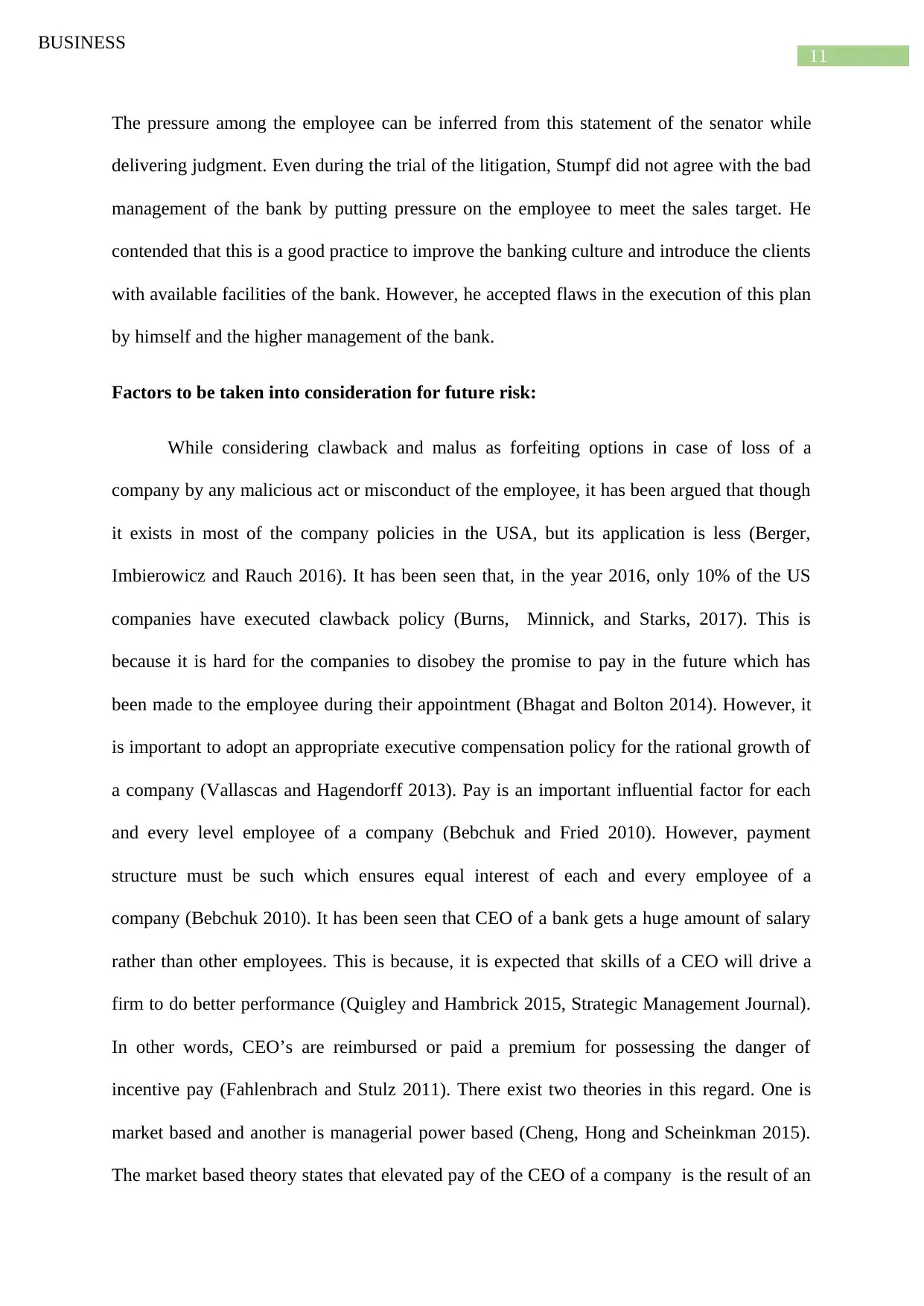
11
BUSINESS
The pressure among the employee can be inferred from this statement of the senator while
delivering judgment. Even during the trial of the litigation, Stumpf did not agree with the bad
management of the bank by putting pressure on the employee to meet the sales target. He
contended that this is a good practice to improve the banking culture and introduce the clients
with available facilities of the bank. However, he accepted flaws in the execution of this plan
by himself and the higher management of the bank.
Factors to be taken into consideration for future risk:
While considering clawback and malus as forfeiting options in case of loss of a
company by any malicious act or misconduct of the employee, it has been argued that though
it exists in most of the company policies in the USA, but its application is less (Berger,
Imbierowicz and Rauch 2016). It has been seen that, in the year 2016, only 10% of the US
companies have executed clawback policy (Burns, Minnick, and Starks, 2017). This is
because it is hard for the companies to disobey the promise to pay in the future which has
been made to the employee during their appointment (Bhagat and Bolton 2014). However, it
is important to adopt an appropriate executive compensation policy for the rational growth of
a company (Vallascas and Hagendorff 2013). Pay is an important influential factor for each
and every level employee of a company (Bebchuk and Fried 2010). However, payment
structure must be such which ensures equal interest of each and every employee of a
company (Bebchuk 2010). It has been seen that CEO of a bank gets a huge amount of salary
rather than other employees. This is because, it is expected that skills of a CEO will drive a
firm to do better performance (Quigley and Hambrick 2015, Strategic Management Journal).
In other words, CEO’s are reimbursed or paid a premium for possessing the danger of
incentive pay (Fahlenbrach and Stulz 2011). There exist two theories in this regard. One is
market based and another is managerial power based (Cheng, Hong and Scheinkman 2015).
The market based theory states that elevated pay of the CEO of a company is the result of an
BUSINESS
The pressure among the employee can be inferred from this statement of the senator while
delivering judgment. Even during the trial of the litigation, Stumpf did not agree with the bad
management of the bank by putting pressure on the employee to meet the sales target. He
contended that this is a good practice to improve the banking culture and introduce the clients
with available facilities of the bank. However, he accepted flaws in the execution of this plan
by himself and the higher management of the bank.
Factors to be taken into consideration for future risk:
While considering clawback and malus as forfeiting options in case of loss of a
company by any malicious act or misconduct of the employee, it has been argued that though
it exists in most of the company policies in the USA, but its application is less (Berger,
Imbierowicz and Rauch 2016). It has been seen that, in the year 2016, only 10% of the US
companies have executed clawback policy (Burns, Minnick, and Starks, 2017). This is
because it is hard for the companies to disobey the promise to pay in the future which has
been made to the employee during their appointment (Bhagat and Bolton 2014). However, it
is important to adopt an appropriate executive compensation policy for the rational growth of
a company (Vallascas and Hagendorff 2013). Pay is an important influential factor for each
and every level employee of a company (Bebchuk and Fried 2010). However, payment
structure must be such which ensures equal interest of each and every employee of a
company (Bebchuk 2010). It has been seen that CEO of a bank gets a huge amount of salary
rather than other employees. This is because, it is expected that skills of a CEO will drive a
firm to do better performance (Quigley and Hambrick 2015, Strategic Management Journal).
In other words, CEO’s are reimbursed or paid a premium for possessing the danger of
incentive pay (Fahlenbrach and Stulz 2011). There exist two theories in this regard. One is
market based and another is managerial power based (Cheng, Hong and Scheinkman 2015).
The market based theory states that elevated pay of the CEO of a company is the result of an
⊘ This is a preview!⊘
Do you want full access?
Subscribe today to unlock all pages.

Trusted by 1+ million students worldwide
1 out of 18
Your All-in-One AI-Powered Toolkit for Academic Success.
+13062052269
info@desklib.com
Available 24*7 on WhatsApp / Email
![[object Object]](/_next/static/media/star-bottom.7253800d.svg)
Unlock your academic potential
Copyright © 2020–2025 A2Z Services. All Rights Reserved. Developed and managed by ZUCOL.


